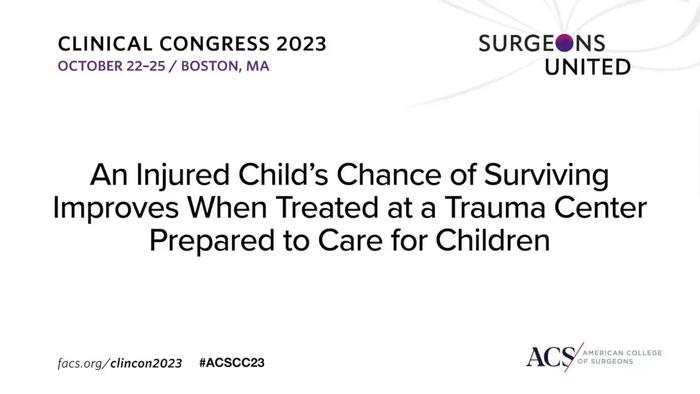Key Takeaways
-
Trauma centers with the highest pediatric readiness scores (93 or greater) on a national assessment have much lower death rates than centers scoring lower.
-
All trauma centers should address gaps in pediatric emergency care — most importantly, the lack of having a pediatric-specific quality improvement plan.
BOSTON (October 20, 2023): Children initially treated at trauma centers with the highest level of preparedness to care for children, called pediatric readiness, are significantly less likely to die than those initially treated at trauma facilities with lower pediatric readiness levels, new research shows. The findings are being presented at the American College of Surgeons (ACS) Clinical Congress 2023.
“What happens in that first hour after injury really impacts whether you survive, so rapid access to trauma center care for kids is important,” said principal investigator Aaron Jensen, MD, FACS, trauma medical director at the University of California, San Francisco (UCSF) Benioff Children’s Hospital Oakland.
“But most children in the United States receive initial trauma care at non-pediatric centers because they are more readily available,” Dr. Jensen said.
Trauma centers that specialize in treating children have the comprehensive infrastructure and resources needed to care for injured children, Dr. Jensen said. Emergency departments (EDs) in centers without comprehensive pediatric capabilities must be ready to resuscitate and stabilize severely injured children and quickly transfer them to pediatric trauma centers, he noted.
Study details
In this study, the investigators aimed to identify a minimum threshold of pediatric readiness among trauma centers that represents the lowest chance of patient death. To do so, they used data from the 2021 national assessment administered by the National Pediatric Readiness Project (NPRP).*
The NPRP works to ensure that all EDs in the U.S. are prepared to provide high-quality emergency care for children. It uses a voluntary survey for EDs to self-assess pediatric readiness across six domains: administration and care coordination, personnel, quality improvement, patient safety, policies and procedures, and equipment and supplies. Survey responses are used to create a weighted pediatric readiness score that ranges from zero to 100.
The new study included 790 U.S. trauma centers, 630 of which completed the NPRP’s 2021 national assessment, contributed data to the ACS National Trauma Data Bank® (NTDB), and treated at least some children from newborns through age 15 years. Most centers were not pediatric trauma centers, Dr. Jensen said.
The research team used ACS Pediatric Trauma Quality Improvement Program risk-adjusted models to estimate the adjusted odds of dying in each trauma center. Center-level adjusted mortality estimates were then compared across quartiles of ED pediatric readiness at the initial treating trauma center.
Centers that reported pediatric readiness in the top 25th percentile (a score of 93 or higher) had the lowest adjusted odds of death, the investigators reported. This high-readiness quartile had 17 to 27 percent lower adjusted odds of death than any other quartile.
Gaps in care
Among the lower-scoring quartiles, Dr. Jensen said, “the most common deficiencies are lack of a pediatric emergency care coordinator, pediatric-specific quality improvement plan, and pediatric disaster preparedness plan.”
The researchers found that having a pediatric-specific quality improvement plan was independently associated with significantly lower odds of death.
Dr. Jensen stressed that the goal of pediatric readiness is not to transform every ED into a pediatric trauma center providing the full spectrum of emergency care for children. Rather, the goal is to help EDs optimize the initial care for pediatric trauma patients. Ways that EDs can improve their pediatric readiness are easy and usually inexpensive, he stated.
“Access for kids to high-quality pediatric trauma care is an achievable goal and has a real impact on kids,” Dr. Jensen said.
NPRP pediatric readiness scores are not publicly available. However, according to Dr. Jensen, almost every ACS-verified Level I pediatric trauma center in the study had pediatric readiness scores in the top quartile. ACS-verified trauma centers are searchable on the ACS website.
Caroline Melhado, MD, a study coauthor and UCSF general surgery resident, presented this research at the conference.
Other study coauthors: Katherine Remick, MD; Amy Miskovic, MS; Bhavin Patel, MPH; Hilary Hewes, MD; Avery B. Nathens, MD, PhD, FACS; Craig Newgard, MD, MPH; Brian Yorkgitis, DO, FACS; and Michael Dingeldein, MD, FACS.
The study authors have no disclosures.
Funding: This research was supported by the Health Resources and Services Administration (HRSA, #U07MC374710100) of the U.S. Department of Health and Human Services (HHS) as part of the Emergency Medical Services for Children Innovation and Improvement Center. The contents are those of the authors and do not necessarily represent the official views of, nor an endorsement, by HRSA, HHS, or the U.S. government.
This research has been accepted for publication in Annals of Surgery.
Citation: Melhado C, et al. The Association Between Pediatric Readiness Scores and Mortality for Injured Children Treated at US Trauma Centers, Scientific Forum, American College of Surgeons (ACS) Clinical Congress 2023.
________________________
* The NPRP is led by the U.S. government’s Emergency Medical Services for Children Program in partnership with the American Academy of Pediatrics, American College of Emergency Physicians, and Emergency Nurses Association.
# # #
About the American College of Surgeons
The American College of Surgeons is a scientific and educational organization of surgeons that was founded in 1913 to raise the standards of surgical practice and improve the quality of care for all surgical patients. The College is dedicated to the ethical and competent practice of surgery. Its achievements have significantly influenced the course of scientific surgery in America and have established it as an important advocate for all surgical patients. The College has approximately 90,000 members and is the largest organization of surgeons in the world. “FACS” designates that a surgeon is a Fellow of the American College of Surgeons.
Journal
Annals of Surgery








































